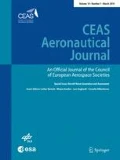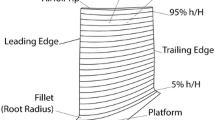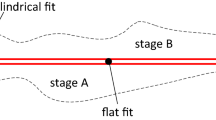Abstract
In modern aviation, the engine-related proportion of the direct operating costs (DOC) is about one quarter. Thereby, the engine-related costs are devided into three roughly equivalent parts: depreciation/financing, fuel and maintenance and overhaul (Rupp in DLRK 2001, 2001). Consequently, an efficient and high technical quality maintenance has a great impact on the DOC. Nowadays, the transition from the exhaust gas temperature based to the condition based maintenance is developing. Thereby, the maintenance, repair and overhaul (MRO) companies provide tailored maintenance actions for each jet engine, depending on the engine history and operation conditions. Obviously, a detailed knowledge of the influence of the different engine components and their features on the engine performance is necessary to accomplish a condition based maintenance. In order to illustrate this, the example of the high pressure compressor (HPC) is shown: The HPC has a strong impact on the gas turbine efficiency and the specific fuel consumption (SFC). Nevertheless, the HPC blading is classified coarsely into serviceable, scrap and repairable. The repairable blades are repaired by a few repair processes, without evaluating the blade geometry in detail. With a detailed knowledge of the geometric main parameters to the aerodynamic performance and their interactions, future repair processes could maintain suited maintenance actions as well as tailored blade sets for the HPC. Therefore, a more efficient maintenance could be achieved to meet future requirements of the costumers. This paper contributes a part to this maintenance development. Therefore, a design of experiments and a sensitivity analysis will be carried out for a HPC-aft stage and compared with previous gained results of a HPC-front stage. Therefore, 700 different stage geometries will be analyzed for their aerodynamic performance and imported to a Kriging Method to generate a meta-model. This meta-model allows a sensitivity analysis for individual geometric properties. The detected sensitivities will be compared to those of the front stage. Changes of the behavior of the stages through the HPC could help the MRO companies to focus on appropriate geometric properties and, therefore, suitable repair processes for each stage and airfoil.


















Similar content being viewed by others
Abbreviations
- B:
-
Blade
- CFD:
-
Computational fluid dynamics
- DOC:
-
Direct operating costs
- DoE:
-
Design of experiments
- EGT:
-
Exhaust gas temperature
- HPC:
-
High pressure compressor
- LE:
-
Leading edge
- N2:
-
High pressure shaft
- RMSE:
-
Root mean square error
- SFC:
-
Specific fuel consumption
- TE:
-
Trailing edge
- TKE:
-
Turbulence kinetic energy
- Tu:
-
Turbulent intensity
- TLM:
-
Turbulent length scale
- TRACE:
-
Turbomachinery Research Aerodynamics Computational Environment
- V:
-
Vane
- VSV:
-
Variable stator vane
- \(c_{\mathrm{p}}\) :
-
Isobar heat coefficient
- D :
-
Distance between wedge points
- H :
-
Absolute duct height
- h :
-
Height
- k :
-
Turbulence kinetic energy
- L :
-
Distance from LE to intersection point
- Ma :
-
Mach number
- n :
-
Rotational speed of N2
- p :
-
Pressure
- \(p_{\mathrm{t}}\) :
-
Total pressure
- \(p_{\mathrm{t}}^{\prime }\) :
-
Relative total pressure
- \(T_{\mathrm{t}}\) :
-
Total temperature
- U :
-
Circumferential speed
- \(V_{\mathrm{ax}}\) :
-
Axial velocity
- \(y^{+}\) :
-
Dimensionless wall distance
- \(\alpha\) :
-
Absolute circumferential flow angle
- \(\beta\) :
-
Absolute radial flow angle
- \(\eta _{\mathrm{is}}\) :
-
Isentropic efficiency
- \(\varphi\) :
-
Flow coefficient
- \(\sigma\) :
-
Standard deviation
- \(\tau _{tt}\) :
-
Temperature rise
- \(\psi\) :
-
Work coefficient
- \(\omega\) :
-
Dissipation rate per unit of TKE
- \(c_{\mathrm{max}}\) :
-
Max. profile camber
- l :
-
Chord length
- \(\hbox {LE}_{\mathrm{asy}}\) :
-
Leading edge asymmetry
- \(\hbox {LE}_\mathrm{s}\) :
-
Leading edge stretching
- \(r_{\mathrm{LE}}\) :
-
Leading edge radius
- \(r_{\mathrm{TE}}\) :
-
Trailing edge radius
- \(t_{\mathrm{LE}}\) :
-
Leading edge thickness
- \(t_{\mathrm{max}}\) :
-
Max. profile thickness
- \(t_{\mathrm{TE}}\) :
-
Trailing edge thickness
- \(\hbox {TE}_{\mathrm{asy}}\) :
-
Trailing edge asymmetry
- \(x_{c_{\mathrm{max}}}\) :
-
Position of max. profile camber
- \(x_{t_{\mathrm{max}}}\) :
-
Position of max. profile thickness
- \(\kappa _1\) :
-
Metal angle at leading edge
- \(\kappa _2\) :
-
Metal angle at trailing edge
- \(\lambda\) :
-
Stagger angle
References
Becker, K., Heitkamp, K., Kügeler, E.: Recent progress in a hybrid-grid CFD solver for turbomachinery flows. In: Proceedings of V. European Conference on Computational Fluid Dynamics (2010)
Kügeler, E.: Numerisches Verfahren zur genauen Analyse der Kühleffektivität filmgekühlter Turbinenschaufeln. PhD thesis, Ruhr-Universität Bochum (2004)
Lange, A., Vogeler, K., Gümmer, V., Schrapp, H., Clemen, C.: Introduction of a parameter based compressor blade model for considering measured geometry uncertainties in numerical simulation. In: ASME GT2009-59937 (2009)
Lange, A., Voigt, M., Vogeler, K., Schrapp, H., Johann, E., Gümmer, V.: Probalistik CFD simulation of a high-pressure-compressor stage taking manufacturing variability into account. In: ASME GT2010-22484 (2010)
Lange, A., Voigt, M., Vogeler, K., Schrapp, H., Johann, E., Gümmer, V.: Impact of manufacturing variability and non-axisymmetry on high-pressure compressor stage performance. In: ASME GT2011-45718 (2011)
Lophaven, S.N., Nielsen, H.B., Sondergaard, J.: DACE a Matlab Kriging toolbox; version 2; informatics and mathematical modelling. Technical University of Denmark, Technical Report No. IMM-TR-2002-12 (2002)
Marciniak, V., Kügeler, E., Franke, M.: Predicting transition on low-pressure turbine profiles. In: Proceedings of V. European Conference on Computational Fluid Dynamics (2010)
Marx, J., Städing, J., Reitz, G., Friedrichs, J.: Investigation and analysis of deterioration in high pressure compressors. In: DLRK Conference (2013)
Nürnberger, D.: Implizite Zeitintegration für die Simulation von Turbomaschinenströmungen. Ph.D. thesis, Ruhr-Universität Bochum. 01 Jan 2004
Reitz, G., Dwinger, K., Schlange, S., Friedrichs, J., Kappei, F.: Analysis of jet engine compressor deterioration and capturing correlations between geometric parameters. In: ISROMAC 2016 (2016)
Reitz, G., Friedrichs, J.: Procedure for analyzing, manipulating and meshing of compressor blades to simulate their flow. Int. J. Gas Turbine Propuls. Power Syst. (JGPP). 8(1), 1–8 (2016)
Reitz, G., Friedrichs, J., Marx, J., Städing, J.: Performance analysis of deteriorated high pressure compressor blades. In: ASME GT2014-25544 (2014)
Reitz, G., Schlange, S., Friedrichs, J.: Design of experiments and numerical simulation of deteriorated high pressure compressor airfoils. In: ASME GT2016-56024 (2016)
Rupp, O.C.: Instandhaltungskosten bei zivilen Strahltriebwerken. In: DLRK 2001 (2001)
Acknowledgements
The authors would like to thank MTU Maintenance Hannover GmbH for funding and for allowing the publication of this work.
Author information
Authors and Affiliations
Corresponding author
Rights and permissions
About this article
Cite this article
Reitz, G., Kellersmann, A., Schlange, S. et al. Comparison of sensitivities to geometrical properties of front and aft high pressure compressor stages. CEAS Aeronaut J 9, 135–146 (2018). https://doi.org/10.1007/s13272-018-0281-8
Received:
Revised:
Accepted:
Published:
Issue Date:
DOI: https://doi.org/10.1007/s13272-018-0281-8




